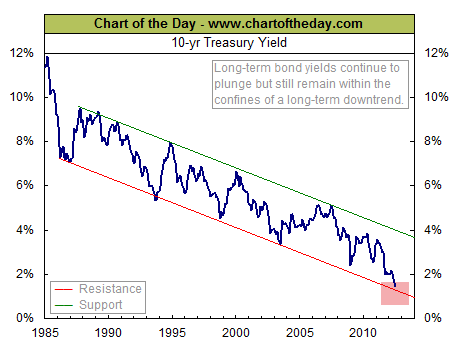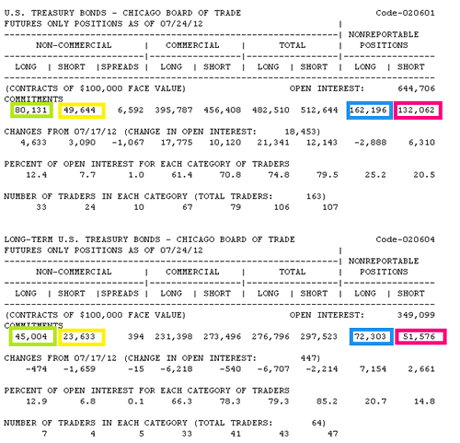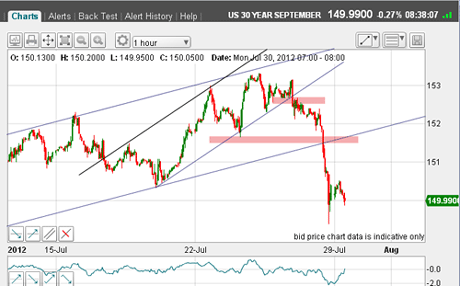This could have a huge impact on all markets
With a massively rising US national debt and a slowing economy, US Treasury bond yields could be about to take off, says John C Burford. Here, he looks at what that could mean for other assets.
Today, I have a little diversion for you from my regular markets the Dow, the euro and gold.
I want to alert you to a situation that, if it develops, will have a major impact on all markets and will necessarily guide my own trading stance. I hope you'll find this useful let me know what you think.
First of all, I want to talk about interest rates as I'm sure you know, the world of finance revolves around them.
MoneyWeek
Subscribe to MoneyWeek today and get your first six magazine issues absolutely FREE

Sign up to Money Morning
Don't miss the latest investment and personal finances news, market analysis, plus money-saving tips with our free twice-daily newsletter
Don't miss the latest investment and personal finances news, market analysis, plus money-saving tips with our free twice-daily newsletter
And, as traders, we need to keep an eye on short-term, medium-term and long-term rates and market expectations for them (as revealed in futures pricing).
I'll tell you why this is
We are not in normal times
In a normal' economy, when demand for loans is high, the pressure is on for higher rates. This goes hand-in-hand with a healthy growing economy.
When demand is low, the reverse is true. Today, we are in a very low interest rate environment across the spectrum in the UK, US, Germany and a few others historically low in many cases.
But as we all know, bond yields in certain eurozone countries are at record highs! This is because these countries are in their own depressions and the market fear is that they will renege on their obligations to investors.
These countries' economies are not in normal' times.
So, can we say that the ultra-low US and UK yields are a result of high bond demand/low supply and unhealthy economies? Will the doubt over the credit-worthiness of most of the eurozone countries spill over into the safe' markets and raise yields?

As a contrarian trader, I'm always looking for reversals and with the market having fallen to the lower tramline, should I start looking now? It appears to be an attractive place - although I confess I haven't been waiting 27 years for this!
Is the bond market about to crack?
With the low yields, the market is relying 100% on the US to keep its obligations to pay all bondholders in full a historically 100% safe bet.
But today, we have a massively rising US national debt and a slowing economy (tax revenues under pressure). If the market starts to doubt the credit-worthiness of the US, there could be an explosive move up in yield (and down in bond pricing).
Generally, for a 30-year bond, the market takes into account expectations for price inflation in the future. If the market sniffs a likely increase in inflation down the road, it will bid bond prices lower.
Today, we have not seen the hyper-inflation that many gold bugs have long forecast. On the contrary, retail price inflation has been falling and that is one reason why bond bears (in which group there are many prominent experts') have been confounded.
So not only have the gold bugs been wrong, but so have the many bond bears at least, so far.
But are they about to be proven correct after all?
Let's turn to the US Treasury market. It's the largest futures market in the world.
To get a clue as to what level of sentiment exists, let's take a look at the Commitments of Traders (COT)data as of 24 July:

The hedge funds (non-commercials) are long:short by a ratio of 1.7:1 (I've added the figures boxed in green (longs) together and divided by those in yellow (shorts) a pretty bullish figure. Small traders, too, are net bullish 1.3:1 (total of blue figures divided by pink).
It seems the scene is primed for a major reversal in yields about now. Let's now have a look at the T-bond chart for timing clues:

(Click on the chart for a larger version)
Last week, as the market was making its high just above the 153 level, I was able to draw the sharply up-sloping tramlines. And when the market broke the upper pink bar, that was my initial short entry.
Note that there was no kiss' to the underside of the lower tramline, which I would normally expect. That told me we could be in for a more substantial decline.
And when the lowest tramline was broken at the same time as the chart support provided by the Tuesday dip to below 152, that was another short entry signal.
The market spiked down on Friday for a near-400 pip decline off the high in an impulse wave doesn't this suggest a third Elliott wave?
Let's see if I can identify some Elliott waves:

(Click on the chart for a larger version)
I believe I can. My third wave is long and strong' and we are in the fourth wave which may extend a little higher. But if this is correct, I will expect a move down to a new low in the fifth wave before finding major support and then an A-B-Cupward correction.
This is my ideal scenario, and I will be looking to take short-term profits in the fifth wave. But the longer-term picture will remain bearish.
Meanwhile, I have moved my protective stops to break-even for a no-risk trade.
But note that if I get my five-wave pattern and reversal, it will confirm (to a high confidence level) that the top in bonds is in at the 153 level. I would love to see a classic positive momentum divergenceat the fifth wave.
Why US bonds are pivotal for asset markets
And I have pencilled in a Dow top as and when the T-bonds reverse at the fifth wave and will be looking to take a major short Dow position then, if not before.
If I'm right, long-term interest rates around the world will start to rise off their record lows.
Imagine the implications for asset markets. Stocks will fall with bonds (a reversal from current relationship), as the market will almost certainly take rising bond yields as risk-off'.
Mortgages will become more expensive, house prices will fall and people will get even gloomier! Thus, another turn of the deflationary screw will take the economy lower.
The US dollar will continue heading up, as they become scarcer. And that's why the Treasury market is pivotal today.
Stay tuned to MoneyWeek Trader. These are thrilling times in the markets and great times for trading if you have a strategy. And that's what I hope you'll learn as you read these articles.
It's been great to see readers leaving comments recently saying they're having success based on what they've learned in these articles and in my workshops. I hope it's starting to fall into place for you. Let me know your thoughts in the comments below.
If you're a new reader, or need a reminder about some of the methods I refer to in my trades, then do have a look at my introductory videos:
The essentials of tramline trading
An introduction to Elliott wave theory
Advanced trading with Elliott waves
Don't miss my next trading insight. To receive all my spread betting blog posts by email, as soon as I've written them, just sign up here . If you have any queries regarding MoneyWeek Trader, please contact us here.
Get the latest financial news, insights and expert analysis from our award-winning MoneyWeek team, to help you understand what really matters when it comes to your finances.
John is is a British-born lapsed PhD physicist, who previously worked for Nasa on the Mars exploration team. He is a former commodity trading advisor with the US Commodities Futures Trading Commission, and worked in a boutique futures house in California in the 1980s.
He was a partner in one of the first futures newsletter advisory services, based in Washington DC, specialising in pork bellies and currencies. John is primarily a chart-reading trader, having cut his trading teeth in the days before PCs.
As well as his work in the financial world, he has launched, run and sold several 'real' businesses producing 'real' products.
-
 Why UK investors are backing British stocks in 2026
Why UK investors are backing British stocks in 2026The UK stock market may be lacking fashionable technology shares but investors are keen to buy British next year
-
 UK inflation live: did inflation fall in November?
UK inflation live: did inflation fall in November?The ONS releases inflation data for November tomorrow (17 December). Has inflation continued its downward trend?